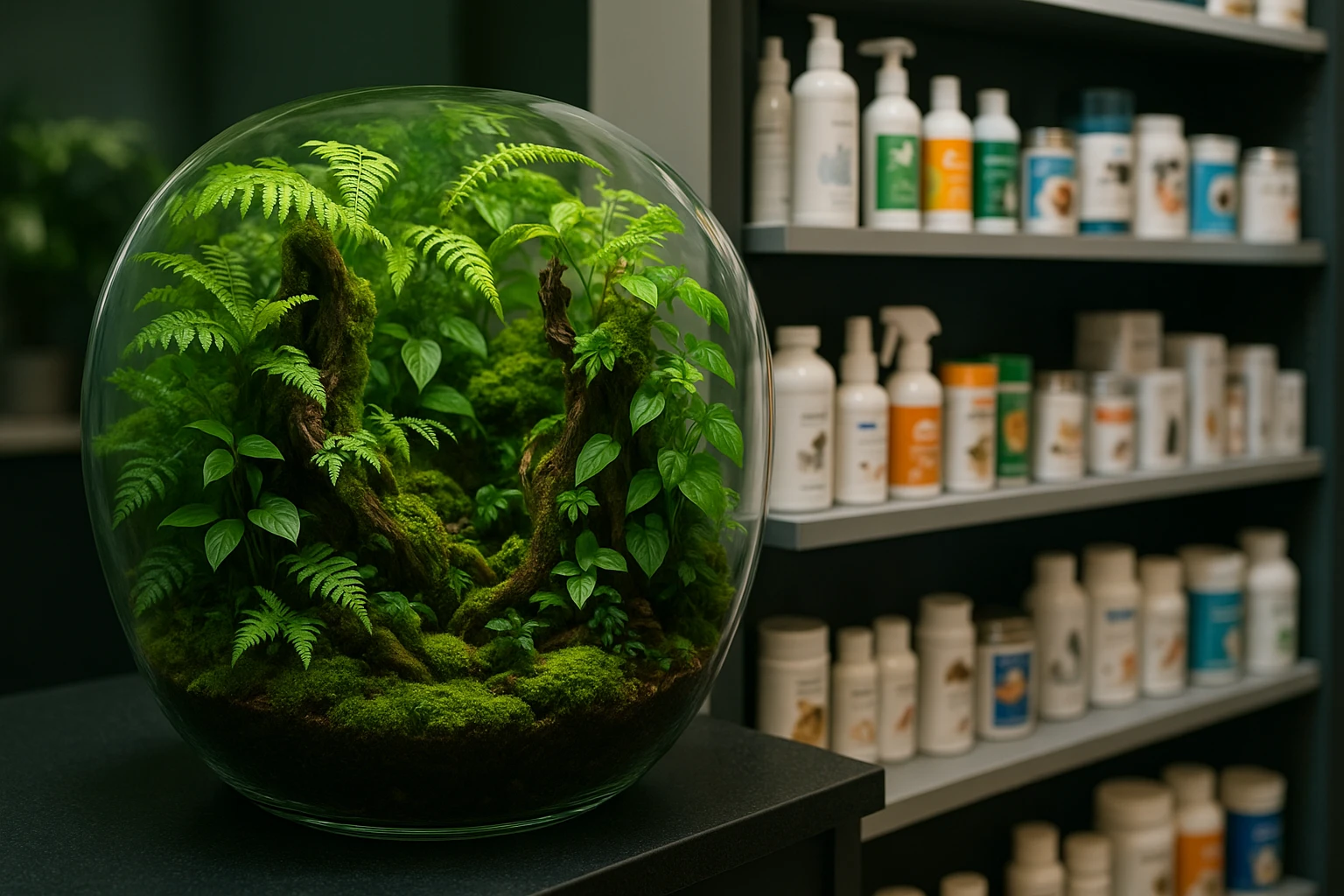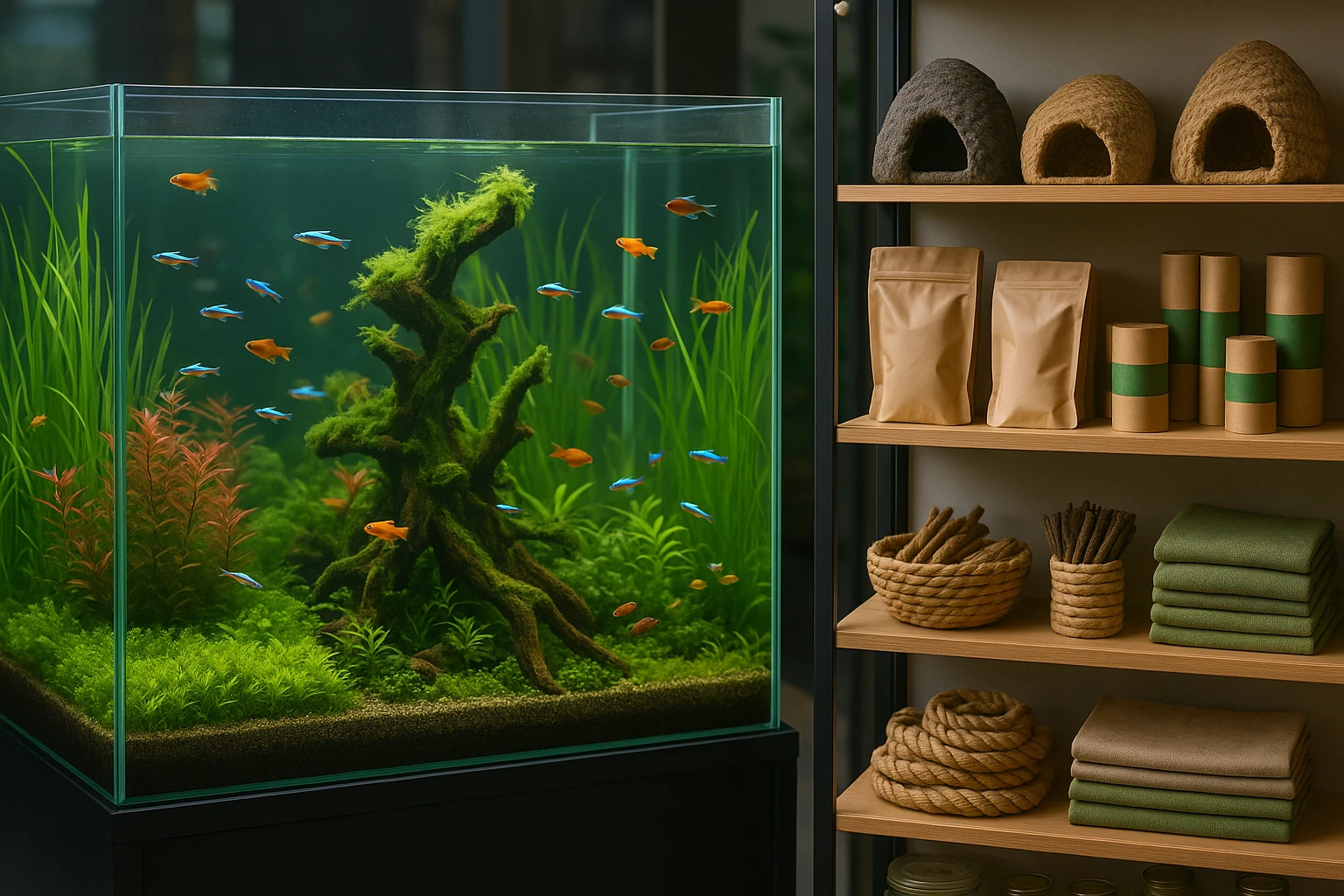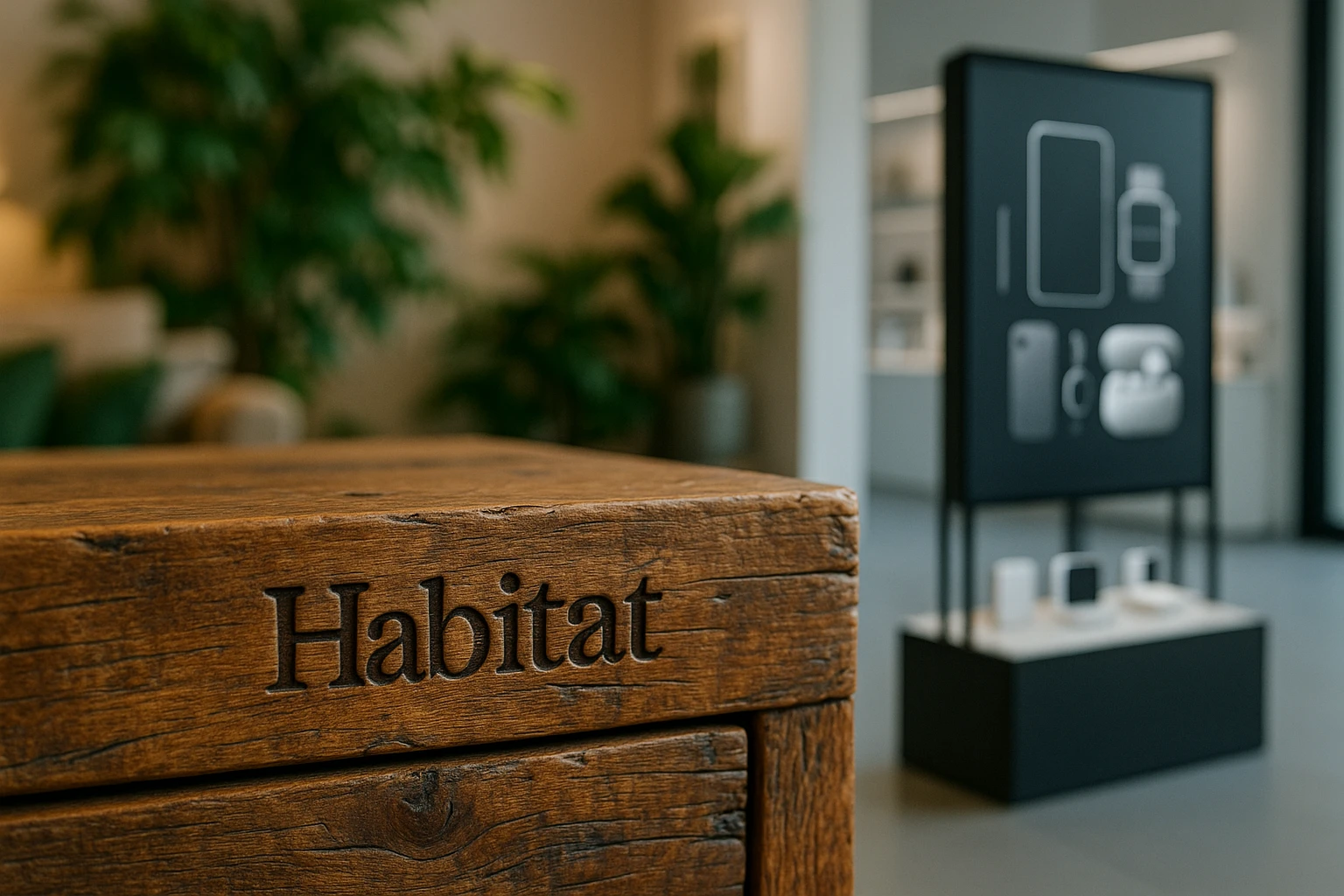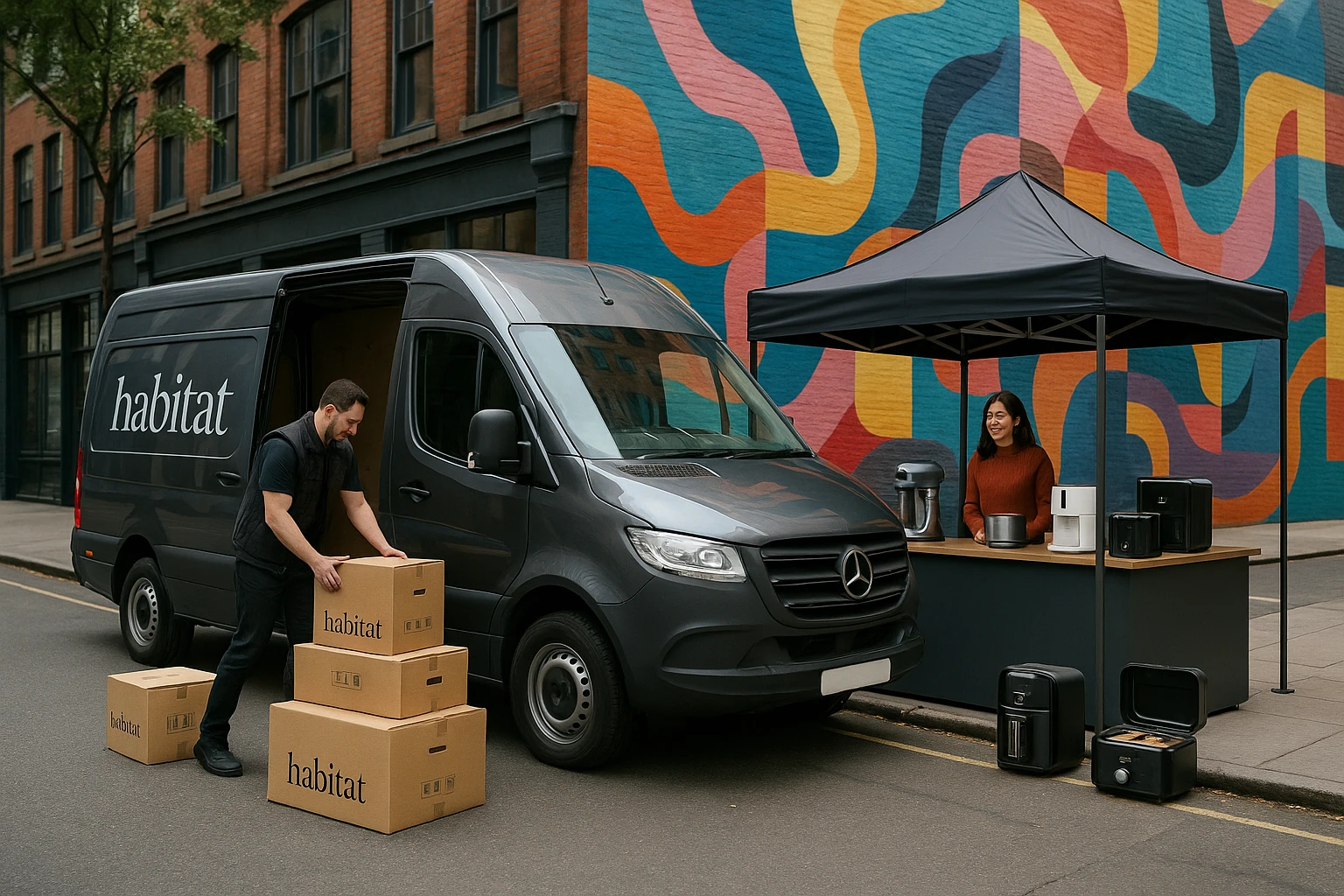Blog sidebar
Category
Recent Posts
- Dec 15, 2025
- Dec 15, 2025
- Dec 15, 2025
- Dec 11, 2025
- Dec 11, 2025
- Dec 08, 2025
- Dec 05, 2025
- Dec 05, 2025

Habitat vs Stomart: A Guide to Interior Design Choices
Contents
Introduction
In a world where pet ownership and animal welfare intersect with innovative solutions, the debate of habitat versus pet stores often sparks intense interest. Many pet enthusiasts have debated whether nurturing a creature’s well-being is best achieved through enriching natural environments or opting for the convenience and diversity of retail outlets. This introduction explores that dynamic by drawing parallels between "Habitat vs Stomart" to illustrate how choices in pet care environments influence animal welfare and customer experience.
Why the choice matters
Diverse environments shape animal behaviour in profound ways, offering either enrichment or limitations. For instance, research into avian species has demonstrated that birds provided with complex, naturalistic enclosures exhibit greater problem-solving abilities and lower stress indicators than those housed in minimalistic cages. These findings highlight the importance of thoughtfully designed habitats in promoting animal welfare—a consideration that extends to both retail and sanctuary contexts.
What we will cover
This article section lays the groundwork for understanding how emerging pet retail brands—exemplified by a hypothetical concept such as Stomart—compare to habitat-focused alternatives. We’ll look at actionable insights, such as how incorporating natural substrate, climbing structures, or sensory enrichment can significantly enhance an animal’s quality of life. A real-world example comes from zoo studies, where primates in enriched habitats show increased social interaction, while those in barren enclosures demonstrate repetitive, stress-related behaviour.
Setting up the comparison
Professionals in the pet industry can leverage insights from both habitat designers and retail experts to create environments that serve animals and audiences alike. By examining how animals behave, thrive, and engage, whether in a richly appointed habitat or a retail-like setting such as Stomart, we can identify key design principles. These include environmental complexity, behavioural enrichment, and the psychological impact on both animals and caretakers.
Through this introduction, we aim to establish a framework for evaluating the nuanced trade‑offs in "Habitat vs Stomart" without bias. Upcoming sections will delve deeper into specific case studies, evidence-based recommendations, and strategic implications for businesses and animal carers exploring this pivotal choice.
Comparative Performance and Practical Applications
Moving seamlessly from our introduction's framework, a deeper comparative lens reveals where Habitat outperforms Stomart, and vice versa, in terms of functionality, usability, and stakeholder impact. Habitat’s strength lies in its proven ecological modelling tools, widely adopted by researchers, NGOs, and government agencies for spatial environmental assessments. Developed by Deltares, it enables modelled Habitat Suitability Index maps by integrating multiple raster layers through rule‑based functions such as broken linear reclassification or formula‑based calculation oss.deltares.nl. This robust analytic foundation has been used across 34 countries, enabling nuanced habitat management decisions in both terrestrial and aquatic contexts oss.deltares.nl.
Conversely, Stomart appears to be a commercial enterprise—originally registered in Poland in 2004—with evolving financial performance that reflects challenges in achieving profitability. According to polskiedane.io, Stomart’s revenues rose from 1.868 million zł in 2022 to 2.382 million zł in 2024, yet the company maintained negative net profit margins, registering a –2 % result in 2024 polskiedane.io. While financials offer limited insight into its product capabilities, this stability in turnover despite losses suggests an organisation still refining its offerings, possibly in a niche market.
Side‑by‑Side Overview
| Aspect | Habitat (Deltares) | Stomart (Poland) |
|---|---|---|
| Purpose | Ecological and spatial modelling for habitat management | Commercial service provider with unspecified focus |
| Primary Users | Researchers, NGOs, government agencies | Likely local market clients, unclear sector coverage |
| Geographic Reach | Used in at least 34 countries globally | Primarily Poland (based on registration data) |
| Financial Health | Non‑profit or institutional; not financially driven | Negative EBIT and net profit in 2024 ≈ –3 % and –2 % respectively polskiedane.io |
Drawing a real‑world parallel, conservation planners addressing river restoration would benefit from Habitat’s spatial capabilities to evaluate how changes in riparian shade or floodplain structure affect species resilience. In contrast, businesses or local service operators researching digital branding options might compare their visibility or offerings across platforms, in a manner similar to navigating between marketing channels like Habitat vs Stomart, though specifics on Stomart’s commercial services remain sparse.
In sum, Habitat stands out with its scientific credibility, open‑access model, and international deployment—providing a benchmark tool for environmental analysis. Stomart, meanwhile, appears more commercially oriented but less transparent, and potentially region‑specific. Understanding these differences equips decision‑makers to select tools aligned with ecosystem priorities or market ambitions.

The Environmental Impact: Habitat vs Stomart
In the debate of Habitat vs Stomart, one critical aspect that demands attention is the environmental impact of each platform. As the world becomes more environmentally conscious, understanding how businesses can contribute to or detract from sustainability efforts is crucial. Habitat focuses on providing natural environments for creatures, which inherently supports ecological balance. For example, terrariums mimic natural ecosystems, fostering biodiversity on a micro level. This not only benefits the local flora and fauna but also educates users on the importance of environmental conservation.
Conversely, Stomart, as a retail-oriented platform, can have varied environmental impacts based on its supply chain practices and product offerings. Retail platforms often face criticism for promoting consumerism, which can lead to excessive waste and resource depletion. However, some retailers within Stomart are shifting towards more sustainable practices. For instance, according to Forbes, many retailers are adopting sustainable packaging and sourcing products ethically. This reflects an emerging trend where business goals align with environmental priorities.
Real-world Applications
Understanding the implications of Habitat vs Stomart can be enhanced by examining real-world applications. Take, for instance, the rise of biophilic design in urban planning which incorporates natural elements into architecture. This trend, often supported by platforms like Habitat, demonstrates how creating spaces that mimic natural environments can enhance human well-being and reduce urban heat island effects. According to a study found in MDPI, integrating nature into city planning can lead to a ten percent reduction in energy consumption due to natural cooling effects.
On the retail side, some companies are leveraging the Stomart model to innovate in eco-friendly products. Brands are now more attuned to the demand for sustainable options, leading to an increase in products made from recycled materials or those that are biodegradable. This evolution is a direct response to consumer pressure, as highlighted in GreenBiz, which notes that 81% of consumers feel strongly that companies should help improve the environment.
As we delve deeper into Habitat vs Stomart, it becomes evident that the shift towards sustainable practices offers promising prospects for aligning economic activities with ecological goals. Balancing economic benefits with environmental responsibility remains a pivotal challenge for both platforms.
Operational Models and Strategic Positioning
While the previous section explored environmental and economic implications, examining how the business models of Habitat and Stomart diverge offers deeper insight into their respective strengths. Habitat, for instance, harnesses the power of its ReStore network to emphasise a circular economy approach—channeling donated furniture, appliances, and building materials into second-hand markets. ReStore KC alone diverts approximately 7 million pounds of usable materials from landfills annually, showcasing a tangible environmental and community impact through reuse initiatives Habitat KC’s official blog habitatkc.org. Meanwhile, Stomart appears to operate as a more technologically driven marketplace, potentially emphasising convenience and reach over reuse-driven environmental outcomes.
Value Propositions and Differentiators
Habitat’s model emphasises community empowerment and social returns alongside environmental benefits. Examples of its broader social impact include generating $36 million in annual economic activity through Habitat Charlotte homeowners, and delivering a fourfold societal return on each invested dollar in Canada, according to the Boston Consulting Group Habitat’s global case for support habitat.org. These figures underscore how Habitat channels social purpose into measurable economic and communal advantages.
In contrast, Stomart may cater to eco-conscious consumers through data transparency and seamless user experience—likely integrating environmental scoring mechanisms to help buyers make informed choices. For example, platforms such as Earthmark use a five-point environmental score to guide users, with reported consumer willingness to pay around 10% more for sustainable offerings and an annual eco-friendly product demand increase of 15% Earthmark’s marketplace insights earthmark.io. If Stomart incorporates similar tools, its advantage lies in appealing to a growing demographic of ethically minded consumers.
Actionable Insights for Stakeholders
- Organisations focused on social impact might prioritise platforms like Habitat that offer holistic, community-oriented benefits beyond mere transactions.
- Those aiming to attract environmentally aware buyers may benefit from integrating transparent eco-scoring systems, similar to those used by Earthmark, to build trust and drive conversion.
- A hybrid approach could deliver the best of both worlds: combining Habitat’s reuse infrastructure with Stomart’s digital agility and scoring transparency would create a robust model that supports both social and environmental values.
Moving forward, it will be crucial for both Habitat and Stomart to articulate how their models align with emerging consumer expectations—merging sustainability, convenience, and tangible societal impact into a cohesive proposition on the evolving digital marketplace landscape.

Agency vs Retail Platform: Strategic Insights
Transitioning seamlessly from our exploration of retail experiences, this section delves into the strategic differences between retail-oriented brands like Habitat and broader platforms such as Stomart. Although not directly compared previously, understanding how Habitat and Stomart differ will equip businesses and shoppers with actionable insights on where each excels.
Core Business Models and Specialist Focus
Habitat operates as a retail brand specialising in contemporary furniture, lighting, and home accessories, offering a curated and design-led product range. Its roots date back to 1964, and its online store reflects that legacy with a focus on aesthetic and functional homeware tailored toward UK customers ecomm.design. In contrast, Stomart functions as a fast-moving, multi-category platform that emphasises trendy, affordable goods across home, beauty, tech, pet supplies, and garden sectors stomart.co.uk. This difference shapes how users engage and what they expect from each site: Habitat leans into design depth, while Stomart emphasises variety and value.
Customer Experience and Content Strategy
Visitors to Habitat benefit from a refined browsing experience tailored for seamless navigation through well-structured collections of furniture and décor. The platform leverages visual clarity and product storytelling to inspire purchase decisions ecomm.design. Conversely, Stomart enhances discovery through frequent new arrivals, promotional banners, and an integrated editorial blog that offers lifestyle and buying guides, fostering discovery across multiple product categories stomart.co.uk. For example, one can find a curated soap gift box for around £28.51 alongside helpful gifting inspiration—all in one streamlined session stomart.co.uk.
Operational Infrastructure and Support
On the backend, Habitat relies on a custom cart setup complemented with analytics tools such as Google Analytics, Hotjar, and Facebook Pixel for customer insights and site optimisation aftership.com. This bespoke approach allows Habitat to tailor its operations precisely to its product offerings and audience needs. On the other hand, while Stomart leverages standard e-commerce infrastructure to support category breadth and dynamic products, its emphasis on user-friendly operations is evident in its secure shopping flow and diverse product catalogue managed through reliable suppliers stomart.co.uk.
Best Practices for Brands and Marketers
When deciding between platforms, brands should weigh their priorities: those that value high-end, design-led presentation and targeted homeware offerings may thrive on platforms like Habitat. In contrast, businesses looking to maximise exposure across multiple lifestyle categories might consider whether to partner with or launch on platforms akin to Stomart. Marketers can naturally embed “Habitat vs Stomart” comparisons by spotlighting how each platform aligns with different consumer intents—design sophistication versus discovery-led bargain hunting.
Real-World Application
Consider a décor designer promoting sustainably crafted lamps. Showcasing these via Habitat would align with design-conscious customers and a focused narrative. In contrast, offering the same lamps on Stomart may lead to broad visibility among budget-savvy shoppers exploring home and lifestyle goods. Each platform supports distinct marketing strategies—niche storytelling on Habitat, broad appeal with discovery paths on Stomart.
This comparative perspective arms readers with clarity on positioning, guiding whether to pursue focused design-driven success, embrace variety-led retail, or even blend both approaches for optimal reach and resonance in the online homeware landscape.
User Experience and Interface Design
When dissecting the differences in user experience between Habitat vs Stomart, the divergence becomes apparent in their digital interface design. Habitat's platform is celebrated for its minimalist aesthetic, emphasising seamless navigation and intuitive design. This approach not only enhances user engagement but also supports storytelling by allowing products to be the focal point, thereby appealing to niche audiences who value design-driven narratives.
In contrast, Stomart thrives on a more dynamic and diverse interface suitable for its broad product range. This expansiveness in design accommodates various shopping paths, catering to a wide audience with different tastes and preferences. For example, Stomart effectively utilises personalised recommendations and multiple product categories to streamline user journeys. This allows customers to discover new items that align with their interests, supporting both spontaneous and planned purchases.
Engagement and Conversion Rates
The effectiveness of these platforms in converting browsing to buying is crucial. Habitat, with its focused aesthetic, often leads to a higher engagement among consumers keen on curated collections. According to a study by Statista, sites with streamlined designs can drastically improve conversion rates by up to 200%. This is particularly true for Habit's target demographic, which values quality over quantity.
Stomart, on the other hand, leverages its interface to enhance conversion through inclusivity and breadth. The layered approach in its design taps into a larger customer base, facilitating diverse user interactions. Stomart’s interface encourages exploration, making it easier for users to stumble upon products they may not have initially considered, thus boosting conversion.
Connecting with Audiences
Personalisation remains a critical factor in retaining consumers on both platforms. Stomart employs algorithms that adapt to user behaviour, offering tailored experiences that increase the likelihood of return visits and sustained customer loyalty. Many professionals integrate platforms like Stomart into their sales strategy due to such adaptable features.
Habitat, while more restrained in scope, excels in delivering targeted content that resonates deeply with particular segments. By focusing on the nuances of design, Habitat creates an intimate shopping experience that fosters strong brand loyalty, capitalising on its niche market position.

Strategic Product Positioning and Customer Engagement
Continuing the exploration of Habitat vs Stomart, it is essential to compare how each brand positions its products and interacts with customers to drive engagement and loyalty. Habitat demonstrated its strategic return to physical retail by placing approximately 20 key furniture pieces—including popular items like the Drio collection chairs and Posada and Montino sofas—in 24 Fabrique de Styles stores, with plans to expand to 34 outlets by mid‑2025. This approach allows customers to experience the quality of Habitat’s offerings firsthand, even without reopening its own stores, reinforcing trust through tactile engagement and immediate visibility in real-world environments interiordaily.com.
On the other side, Stomart Online emphasises a seamless digital experience tailored for convenience and variety. Based in London, the eCommerce platform boasts a broad inventory across categories like home goods, tech accessories, fashion, and pet supplies, and underscores quality control through partnerships with reputable suppliers stomart.co.uk. Stomart’s value proposition centres on accessibility and reliability, allowing customers globally to browse a comprehensive catalogue, benefit from secure payment options, and rely on consistent customer service—all without stepping into a store.
For example, a customer furnishing a study might appreciate Stomart’s ability to offer gadgets, décor, and small furniture in one transaction, with reliable delivery and returns. Meanwhile, a buyer seeking a larger sofa may be drawn to Habitat’s in‑store presence to evaluate pieces like the Montino sofa in person before purchasing. Each channel delivers unique strengths: tactile assurance versus expansive convenience.
In real-world applications, blending these strengths can be particularly effective. Businesses could replicate Habitat’s hybrid model by initiating pop-up displays or collaborations with established retailers to showcase flagship pieces. Similarly, they could adopt Stomart’s approach by enriching their online storefronts with intuitive navigation, comprehensive item descriptions, and trusted supplier partnerships. When combining such tactics, customers benefit from both tangible experiences and digital flexibility—enhancing satisfaction and reinforcing brand credibility.
Ultimately, understanding the nuances of Habitat vs Stomart highlights the importance of matching engagement strategies with customer expectations. Retailers who learn from Habitat’s revival by embracing experiential touchpoints, along with Stomart’s dedication to variety and seamless support, can craft compelling and holistic customer experiences—regardless of whether purchases are made online or offline.
Enhancing Customer Engagement Through Innovation and Multichannel Strategies
To build on the momentum established earlier in the article, it is valuable to explore how modern approaches to customer engagement draw lessons from leading brands. For instance, while Habitat revitalised its presence by introducing immersive flagship stores that bridge digital and physical touchpoints—as seen in its Tottenham Court Road redesign featuring interactive screens and editorial content to drive online awareness and engagement—retailers like Stomart may pursue similar innovation to stay competitive in evolving markets. Habitat’s move underlines how experiential retail can reinforce an online core to deliver a seamless journey across channels retailgazette.co.uk.
Integrating Digital and Physical Experiences
Retailers keen on replicating Habitat’s success should consider integrating interactive digital elements into physical environments. Habitat’s mini‑store formats within supermarkets enabled customers to "touch and feel" products while browsing the full range online via in‑store digital screens—this effectively blended convenience with sensory experience retailgazette.co.uk. A business model like Stomart’s could benefit from similar integration, enabling consumers to explore extended product ranges and obtain real‑time support while maintaining the authenticity of in‑person interactions.
Learning from Campaign Strategies
A thoughtfully executed marketing campaign can also drive brand resurgence. Habitat’s evocative television campaign, "We all look, but only some of us see", emphasised design appeal over typical product promotion, resulting in a 100% increase in brand consideration and a 226% surge in sales of a featured item thinkbox.tv. This strategy highlights that emotional resonance and creative storytelling often outperform traditional advertising tactics. Retail platforms might, therefore, adopt similarly compelling narratives—especially when promoting curated selections or exclusive collaborations.
Actionable Insights for Retailers
- Embed touch‑and‑feel zones with digital kiosks to enhance product discovery while bridging online and offline offerings.
- Design campaigns that appeal to viewers’ emotions, such as aspirational lifestyle narratives, rather than solely pushing product specs.
- Develop store formats tailored to customer convenience—whether micro‑stores in high‑traffic areas or pop‑ups offering click‑and‑collect services.
By integrating tactile engagement with digital convenience and storytelling that strikes a chord, retailers can craft holistic strategies that patrons appreciate. This approach aligns well with how forward‑thinking brands such as Habitat and Stomart evolve to meet diverse consumer needs, ensuring that both discovery and purchase experiences are memorable and efficient.

Customer Experience and Fulfilment Advantages
Transitioning smoothly from the overview of design philosophy and product offerings, it's crucial to delve into the operational strengths that differentiate the brands. Habitat, now a key homewares label within the Sainsbury’s group via Argos, offers a seamless shopping experience anchored in logistics and flexibility. Customers benefit from same-day delivery across approximately 90 % of the UK, the convenience of Click & Collect from thousands of Argos and Sainsbury’s stores, and the ability to return purchases at any Argos location within 30 days Habitat and Argos integration details.
By contrast, Stomart operates as a dedicated online platform based in London, offering a wide-ranging and regularly updated catalogue across categories from home goods to fashion and tech accessories. The brand emphasises its streamlined shopping journey, reliable worldwide shipping, and responsive post-purchase support Stomart’s mission and customer service.
Real-World Fulfilment Scenarios
For instance, a UK homeowner needing a new lamp urgently can browse Habitat’s online range and select same-day delivery, thanks to Argos’s extensive logistics network and storefronts. This tight integration ensures both speed and peace of mind. On the other hand, a customer aiming to source multiple items—such as a kitchen gadget, pet accessory, and tech novelty—can consolidate their purchases via Stomart's versatile platform, taking advantage of trend-based product curation and efficient dispatch, ideal for gift-giving or home refreshes.
Actionable Insight: Match Experience to Priority
- If rapid delivery and in-person collection are essential—especially for urban UK dwellers—Habitat’s consolidated model with Argos positions it as the more practical option.
- Alternatively, if shoppers prioritise broad product variety, inspiration, and international shipping capability, then Stomart’s approach aligns better with those needs.
Both brands illustrate how operational infrastructure underpins user satisfaction. Habitat’s physical network enhances immediacy, while Stomart’s digital-first strategy offers flexibility and elegant inventory breadth. Understanding how each fulfils orders in tangible settings helps businesses and consumers alike weigh the experience based on convenience, delivery speed, and product diversity—reflecting the nuanced dynamics of Habitat vs Stomart.
Integration and Ecosystem Support
Moving seamlessly from the discussion on operational models at Habitat and Stomart, this part explores how robust integration with broader ecosystems enhances value. In today’s marketplace, the ability to link platforms with complementary services—such as payment processors, logistics partners and marketing tools—is essential to delivering efficiency and business scalability.
Payment and Transaction Ecosystem
Both vendors support multiple payment methods, but Habitat emphasises integration with major gateways and enterprise-grade analytics through partnerships. For instance, Habitat ReStores that have moved online benefit from tools like New Relic APM to monitor performance and stability in real-time—an integration that supports smoother transaction processing and customer experience AppsRunTheWorld’s profile. In comparison, Stomart’s digital-first model leans heavily on headless commerce APIs, enabling frictionless plug-ins with third-party systems for checkout, tax, fraud detection, and more.
Logistics and Fulfilment Integration
Transporting goods accurately and efficiently requires dynamic fulfilment networks. Habitat’s physical network of ReStores offers flexibility by combining in‑store pickup with local delivery—an advantage for bulky or time-sensitive items—while still toggling between local inventory and broader channels like eBay to widen reach Habitat ReStore announcement. Stomart, with its digital-first approach, excels in orchestrating shipping across wide geographies, leveraging integrated carriers and real-time tracking, thereby offering a modern, scalable delivery ecosystem.
Marketing and Visibility Ecosystem
On the marketing front, Habitat benefits from campaigns that extend beyond traditional retail into immersive storytelling. Their recent collaboration with Pinterest—called “The Home of Attention”—showcases how curated visual content can drive product discovery via 360° shoppable experiences Retail Systems coverage. Conversely, Stomart’s digital architecture allows brands to integrate dynamically with SEO-led marketplaces, social commerce channels and influencer platforms, supporting more agile targeting and performance-based acquisition.
By combining these insights, businesses can better assess how Habitat vs Stomart platforms may fit into their broader ecosystem strategy—balancing the reliability of physical presence with the agility of digital-first integrations to meet both operational and consumer demands.

Achieving the Best of Both Worlds: Blending Physical Presence and E‑Commerce
In today’s retail landscape, a hybrid approach combining physical touchpoints with robust online platforms can provide a competitive edge. For instance, Habitat’s recent relaunch demonstrates this hybrid strategy in action: although the brand no longer operates standalone stores, it has partnered with Fabrique de Styles to offer product corners in 24 French retail locations, planning to expand to 34 by mid‑2025, enabling customers to experience furniture in person before purchasing online. This approach not only boosts visibility but also restores customer trust and sensory engagement with the brand interiordaily.com.
In contrast, Stomart has built its value proposition entirely online. Since its launch in 2019, the e‑commerce platform has offered a diverse selection—from home goods and kitchenware to tech and beauty—complemented by a content‑rich blog that aids discovery and inspires purchases. Its streamlined design and seasonal highlights reduce decision fatigue and improve conversion rates, making shopping both fast and enjoyable crunchbase.com.
Considering these models, businesses must weigh the benefits and challenges. Physical activations, like Habitat’s retail corners, reinforce brand presence and tactile experiences, which can enhance perceived quality for high‑investment items such as sofas or dining tables. Yet this comes with higher logistics and overhead. On the other hand, Stomart’s all‑digital format enables leaner operations, wide inventory reach and real‑time updates, though it may struggle to convey texture or scale.
A practical application could involve deploying pop‑up spaces for flagship items—such as Habitat’s Drio collection chairs and Montino sofas—to complement an online funnel. This method allows customers to «try‑before‑you‑buy» while keeping facilities lean interiordaily.com.
Ultimately, striking an optimal balance between experiential touchpoints and digital efficiency is key. Businesses analysing opportunities in the home‑ware sector can learn from both: integrate tactile product glimpses with seamless online fulfilment to meet modern shopper expectations. In doing so, they can leverage the best of physical and digital strategies to drive both engagement and sales.
Conclusion: Navigating the Future of Homeware Retail
In the contemporary landscape of homeware retail, understanding the distinctions and overlaps between Habitat and Stomart is crucial. Both brands exemplify the importance of blending traditional retail experiences with modern digital strategies. As businesses adapt to shifting consumer preferences, they can take cues from how each brand markets its unique set of offerings.
One pivotal takeaway is the necessity of integrating both tactile and online shopping experiences. Professionals looking to expand in the homeware sector should focus on creating seamless transitions between in-store and digital platforms. This means not only optimising websites for a smooth e-commerce experience but also enriching physical stores with interactive, tech-driven solutions. For instance, augmented reality applications that allow customers to visualise how products fit into their homes could enhance the customer journey, bridging the gap between the digital and the tangible.
It's also essential for businesses to leverage data analytics to understand customer preferences and behaviours better. By doing so, they can personalise marketing campaigns, thus increasing engagement and conversion rates. The strategic use of customer data enabled by platforms like Google Analytics or Shopify Insights can furnish retailers with the necessary tools to tailor their offerings more precisely to customer needs. Implementing these insights effectively can set businesses apart from their competition.
Another significant aspect is sustainability, which has become a key selling point for many consumers. Companies drawing inspiration from Habitat vs Stomart should prioritise eco-friendly practices, such as using sustainable materials or implementing recycling programmes. According to a study by Nielsen, 73% of global consumers say they would definitely or probably change their consumption habits to reduce their environmental impact (Nielsen Study).
As we usher in an era where the boundaries between online and offline continue to blur, the ability to adapt and innovate will determine success. For businesses eager to make their mark, utilising resources like market analytics and sustainable practices can provide a competitive edge. To get started with these strategies, consider using Stomart for comprehensive support in digital transformation and market positioning. By embracing these insights, businesses can thrive in an ever-evolving market landscape.
Share
YOU MAY ALSO LIKE
- Dec 15, 2025
- Dec 15, 2025
- Dec 15, 2025
- Dec 11, 2025
- Dec 11, 2025
- Dec 08, 2025
- Dec 05, 2025
- Dec 05, 2025
- Dec 02, 2025
- Dec 01, 2025
- Dec 01, 2025
- Nov 30, 2025
- Nov 30, 2025
- Nov 29, 2025
- Nov 25, 2025
- Nov 24, 2025
- Nov 23, 2025
- Nov 22, 2025
- Nov 21, 2025
- Nov 21, 2025
- Nov 21, 2025
- Nov 21, 2025
- Nov 21, 2025
- Nov 21, 2025
Category
Recent Posts
- Dec 15, 2025
- Dec 15, 2025
- Dec 15, 2025
- Dec 11, 2025
- Dec 11, 2025
- Dec 08, 2025
- Dec 05, 2025
- Dec 05, 2025



















































